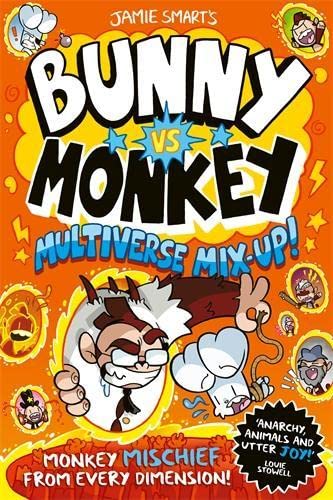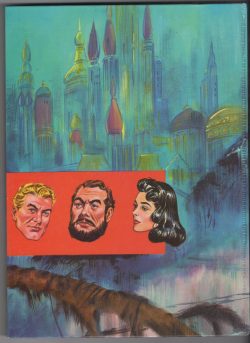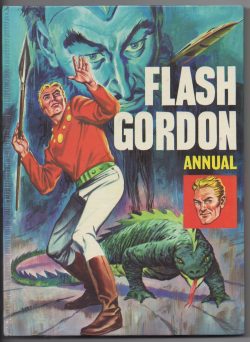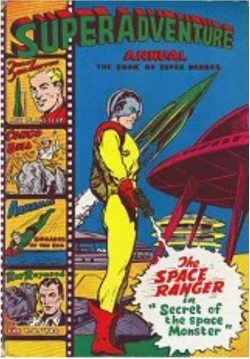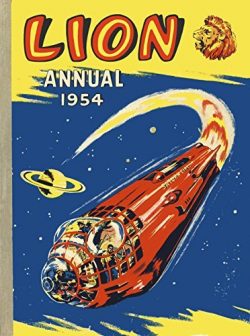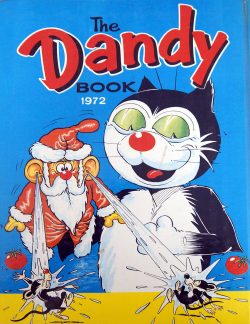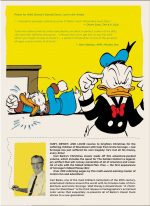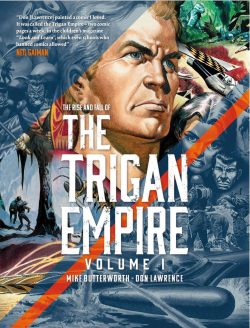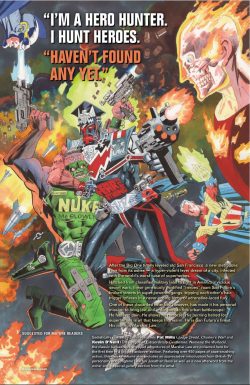

By Jack Kirby, Gerry Conway, Mike Royer, D. Bruce Berry & various (DC Comics)
ISBN: 978-1-4012-7469-6 (Omnibus HB) (volume 1 TPB/Digital edition)
Win’s Christmas Gift Recommendation: Epic – if not Prophetic – Entertainment… 10/10
This book is huge and heavy: 191 x 56 x 280 mm, 880 slick pages and topping the scales at 2.75 kilos – that’s more than six pounds! Believe it or not, it’s actually worth every second of time you spend on it, but be warned that you’ll need strong arms and sturdy wrists to get the best out of it…
Jack Kirby (28th August 1917 – 6th February 1994) was – and nearly 30 years after his death, remains – the most important single influence in the history of American comics. There are innumerable accounts of and testaments to what the man has done and meant, and you should read those if you are at all interested in our medium.
Kirby was a man of vast imagination who translated big concepts into astoundingly potent and accessible symbols for generations of fantasy fans. If you were exposed to Kirby as an impressionable child you were his for life. To be honest, that probably applies whatever age you jump aboard the “Kirby Express”…
For those of us who grew up with Jack, his are the images which furnish and clutter our interior mindsets. Close your eyes and think “robot” and the first thing that pops up is a Kirby creation. Every fantastic, futuristic city in our heads is crammed with his chunky, towering spires. Because of Jack we all know what the bodies beneath those stony-head statues on Easter Island look like, we are all viscerally aware that you can never trust great big aliens parading around in their underpants and, most importantly, we know how cavemen dressed and carnosaurs clashed…
Synonymous with larger than life characters and vast cosmic imaginings, Jack “King” Kirby was an astute, spiritual man who had lived through poverty, prejudice, gangsterism, the Depression and World War II. He experienced Pre-War privation, Post-War optimism, Cold War paranoia, political cynicism and the birth and death of peace-seeking counter-cultures, but always looked to the future while understanding human nature intimately.
In the late 1930s, it took a remarkably short time for Kirby and his creative collaborator Joe Simon to become the wonder-kid dream-team of the new-born comic book industry. Together they produced a year’s worth of influential monthly Blue Bolt, dashed off Captain Marvel Adventures (#1) for overstretched Fawcett, and – after Martin Goodman appointed Simon editor at Timely Comics – launched a host of iconic characters including Red Raven, Marvel Boy, Mercury/Hurricane, The Vision, Young Allies and million-selling mega-hit Captain America.
When Goodman failed to make good on his financial obligations, Simon & Kirby were snapped up by National/DC, who welcomed them with open arms and a fat chequebook. Bursting with ideas the staid industry leaders were never really comfortable with, the pair were initially an uneasy fit, and awarded two moribund strips to play with until they found their creative feet: Sandman and Manhunter.
They turned both around virtually overnight and, once safely established and left to their own devices, switched to the “Kid Gang” genre they had pioneered at Timely. Joe & Jack created wartime sales sensation Boy Commandos and Homefront iteration The Newsboy Legion before being called up to serve in the war they had been fighting on comic pages since 1940.
Once demobbed, they returned to a very different funnybook business, and soon after left National to create their own little empire…
Simon & Kirby ushered in the first American age of mature comics – not just by inventing the Romance genre, but with all manner of challenging modern material about real people in extraordinary situations before seeing it all disappear again in less than eight years.
After years of working for others, Simon & Kirby established their own publishing house: making comics for a far more sophisticated audience, only to find themselves in a sales downturn and awash in public hysteria generated by an anti-comicbook pogrom. Their small stable of magazines – generated for an association of companies known as Prize, Crestwood, Pines, Essenkay and Mainline Comics – blossomed and as quickly wilted when the industry contracted throughout the 1950s, but had left future generations fascinating ventures such as Boys’ Ranch, Bullseye, Crime Does Not Pay, Black Magic, Boy Explorers, Fighting American and the entire genre of Romance Comics…
Hysterical censorship-fever spearheaded by US Senator Estes Kefauver and opportunistic pop psychologist Dr. Frederic Wertham led to witch-hunting Senate hearings. Caving in, most publishers adopted a castrating straitjacket of draconian self-regulatory rules. Crime and Horror titles produced under the aegis and emblem of the Comics Code Authority were sanitised and anodyne affairs in terms of mature themes, political commentary, shock and gore even though the market’s appetite for suspense and the uncanny was still high. Crime comics vanished as adult sensibilities challenging an increasingly stratified and oppressive society were suppressed. Suspense and horror were dialled back to the level of technological fairy tales and whimsical parables…
Simon left the business for advertising, but Jack soldiered on, taking his skills and ideas to safer, more conventional, less experimental companies. As the panic abated, Kirby returned briefly to DC Comics, working on bread-&-butter anthological mystery tales and revamping Green Arrow (at that time a back-up feature in Adventure Comics and World’s Finest Comics) whilst concentrating on his passion project: newspaper strip Sky Masters of the Space Force.
During that period Kirby also re-packaged a super-team concept that had been kicking around in his head since he and Joe had closed their innovative, ill-timed ventures. At the end of 1956, Showcase #6 premiered the Challengers of the Unknown…
After three more test issues they won their own title with Kirby in command for the first eight. Then a legal dispute with Editor Jack Schiff exploded and the King was gone…
He found fresh fields and an equally hungry new partner in Stan Lee at the ailing Atlas Comics outfit (which had once been mighty Timely) and launched a revolution in comics storytelling…
After more than a decade of a continual innovation and crowd-pleasing wonderment, Kirby felt increasingly stifled. His efforts had transformed the dying publisher into industry-pioneer Marvel, but that success had left him feeling trapped in a rut. Thus, he moved back to DC and generated another tidal wave of sheer imagination and pure invention. The result was experimental adult magazines Spirit World and In the Days of the Mob and a stunning reworking of Superman’s Pal Jimmy Olsen – and by extension, all DC continuity. The latter was a prelude to his landmark Fourth World Saga (Forever People, New Gods and Mister Miracle): the very definition of something game-changing and far too far ahead of its time…
Kirby instinctively grasped the fundamentals of pleasing his audience and always strived diligently to combat the appalling prejudice regarding the comics medium – especially from industry insiders and professionals who despised the “kiddies world” they felt trapped in. After his controversial, grandiose Fourth World titles were cancelled, Kirby explored other projects that would stimulate his own vast creativity yet still appeal to a market growing ever more fickle. These included science fictional survival saga Kamandi, supernatural stalwart The Demon, traditional war stories starring established DC team The Losers, OMAC: One Man Army Corps and even a new Sandman – co-created with old pal Joe Simon.
However, although ideas kept coming (Atlas, Kobra, a new Manhunter and Dingbats of Danger Street), once again editorial disputes took up too much of his time. Reluctantly, he left again, choosing to believe in promises of more creative freedom elsewhere…
As early as 1974, worn down by a lack of editorial support and with his newest creations inexplicably tanking, Kirby considered a return to Marvel, but – ever the consummate professional – scrupulously carried out every detail of an increasingly onerous and emotionally unrewarding DC contract. Although The Demon was cancelled after 16 issues and he needed another title to maintain his Herculean commitments (Jack was legally obliged to deliver 15 completed pages of art and story per week!) Kamandi – The Last Boy on Earth had found a solid and faithful audience. It also provided further scope to explore big concepts as seen in thematic companion OMAC: One Man Army Corps. Both series gave Kirby’s darkest assumptions and prognostications free rein, and his “World That’s Coming” has proved far too close to the World we’re frantically trying to fix or escape from today…
Kirby’s return to Marvel in 1976 was much hyped and eagerly anticipated at the time, but again proved controversial. New works like The Eternals and Devil Dinosaur found friends rapidly, but his return to earlier – continuity-locked – creations Captain America and Black Panther divided the fanbase.
Kirby was never slavishly wedded to what had come before, and preferred, in many ways, to treat his stints on titles as a “Day One”: a policy increasing at odds with the close-continuity demanded by a strident faction of the readership…
There’s no need for any of that here as DC’s interconnected universe takes a distant back seat to amazement, adventure and satirical commentary for most of Kirby’s tenure…
This frankly monstrous hardback collection gathers arguably his boldest, most bombastic and certainly most successful 1970s DC creation: collecting Kamandi – The Last Boy on Earth #1-40 (cover-dated October/November 1972- April 1976): every issue Kirby was involved with, but not the 19 issues that staggered on after under lesser creative lights once he had returned to Marvel…
Preceded by inker/letterer Mike Royer’s Introduction ‘When Kirby Called!’ and supported by more ancillary features at the end, the magic opens with the introduction of ‘The Last Boy on Earth!’ as he explores a shattered world that has grown from the rubble of Mankind’s achievements and mistakes…
A signature of the series was large panels and vistas, particularly spectacular and breathtaking double-page spreads on pages 2-3 of almost every episode: adding an aspect of wide-screen cinematic bravura. It’s especially effective here as a capable, well-armed teenager paddles through the sunken ruins of New York City. The explorer has recently emerged from total isolation in a hermetically sealed bunker designated “Command D”, where he was schooled by his grandfather and constantly viewed a vast library of 1970s microfilm and news recordings. The boy calls himself “Kamandi”…
Having obliviously sat out the seemingly overnight decline and fall of humanity – in which atomic armageddon clearly played a major but not exclusive role, the boy mentally catalogues unbelievable and incomprehensible change on every level resulting from the mysterious catastrophe now called “The Great Disaster”…
This world is nothing like his education promised. Wreckage and mutant monsters abound, the very geography has altered and humans have somehow devolved into savage, non-verbal beasts hunted and exploited by a number of animal species who have gained intellect comparable to his own… and the power of speech. Most of them are engaged in wars for dominance, fuelled by territorial aggression and fostered by the scavenged remnants of humanity’s technologies…
When the boy returns to the bunker, he finds it has finally been breached and his grandfather is dead at the hands of opportunistic wolves far too much like men. Shocked, furious and now utterly alone, Kamandi ruthlessly fights his way out and sets off to find what else is out there in this scary new world…
When he reaches the remains of the New Jersey Turnpike, the boy stumbles into the new political reality when he is captured by mounted cavalry tigers (horses appear to be one species that never made the evolutionary leap to intellectual comprehension and personal autonomy).
A formal army of conquest, the tigers devotedly serve charismatic leader Great Caesar, who plans to unite Earth AD (“After Disaster”) under his militant banner. Here that means crushing a force of gun-toting leopards, but – well aware that their liege-lord is obsessed with weird devices and strange phenomena from the past – they make time to send the weird “talking animal” back to ‘The Royal City Kennels!’
It’s a mixed blessing all around. The human is preened and pampered but also kicked around by smug tiger soldiers, before he discovers Caesar’s greatest secret. The warrior king has recovered an atomic missile and made “the warhead” the central focus of a martial cult, and is outraged when Kamandi recognises and tries to destroy it…
In the aftermath, the troublesome boy is surrendered to the care of the conqueror’s chief scientist. A dog named Doctor Canus, he plays a deep game: advising the tiger army over recovered artefacts, whilst keeping huge secrets from his paymasters. The biggest one immeasurably lifts Kamandi’s crushed spirits when the dog introduces another talking human he’s sheltering…
However, although he’s rational, erudite and friendly, Ben Boxer isn’t exactly human!
The utterly jam-packed first issue also provides a map of what the Americas have become in ‘Kamandi’s Continent’ after which the series advanced to a monthly schedule with the second issue, as the young wanderer encounters more terrifying wonders in ‘Year of the Rat!’
Supplemented at the end by Kirby’s editorial codicil ‘The Great Earth Cataclysm Syndrome!’, this tale sees Ben and the boy escape Great Caesar’s compound when the stranger displays a secret power. Ben and his missing companions are nuclear mutants who can transition from flesh & blood to organic steel by internal fission, and after overpowering their tiger guards they flee together in a submersible vehicle. As they search the sunken remains of New York City for missing mutants Steve and Renzi, they are attacked by the avaricious evolved rats who took them and the flying craft they came in…
The rats are the ultimate scavenger society, stockpiling humanity’s detritus and exploiting whatever they understand of it. Once they add their two new captives to the pile, Ben and Kamandi react, explosively breaking free and escaping with Boxer’s rescued comrades in their reclaimed “Traveller”…
Great Caesar’s main opposition is a nation of militant gorillas, and #3 introduces them when the Traveller’s southward flight to the mutants’ home of “Tracking Site” pauses to survey what was once Nevada. When Kamandi is separated from the mutants and caught up in an animal round-up, he’s taken to a vast city to be broken for service…
As Ben, Steve and Renzi discover a monster-infested space museum and encounter ‘The Thing that Grew on the Moon!’, recalcitrant Kamandi is rebelling against brutal animal trainer Chaku the Mighty before fleeing into the rubble of Las Vegas where all concerned parties converge for a spectacular showdown…
Issue #4 finds the humans seeking to replenish supplies in the aftermath, only to be separated again when tiger scouts clash with the gorillas. In an extended skirmish Kamandi is captured by the simians, only to stage a mass animal breakout and liberate a tiger in ‘The Devil’s Arena!’ However, Prince Tuftan, son of Great Caesar, seems quite happy to stay a prisoner as the two armies clash. He has his eyes on a lost weapon of the ancients, but it’s one Kamandi cannot allow to fall into any militarist’s paws…
Despite Kamandi’s act of humanitarian sabotage, Tuftan allies with the weird talking animal seeking safety as the battle reaches appalling heights of bloodshed. Recaptured by gorillas, the last boy frees more caged humans and meets one who has the rudiments of speech and enough intellect to follow him and Tuftan as they make a break for friendly lines.
There are none for humans and when they reach the Tigers ‘Killing Grounds!’, the grudge-bearing emperor makes the boy battle an enraged gorilla warrior in a deathmatch…
When Tuftan sabotages that moment of entertainment, Kamandi becomes a state problem until the regrouped gorillas counterattack. With slaughter for all the only prospect, the boy buys his own life by suggesting an honourable compromise to be determined by fate and ‘The One-Armed Bandit!’…
Given his freedom and a fast car, Kamandi rides away and into tragedy with the evermore loquacious girl who calls herself ‘Flower!’ but they are soon captured again. This time it’s lions; however their fate seems to be a blessing as Sultin and his Rangers relocate the strange animals to The Sanctuary: a wildlife preserve in what used to be Texas, where humans can live their days in peace and security. Sadly, the place is a target for poachers and Kamandi’s chance for love and companionship with his own kinds ends in shocking tragedy and grief when a pair of pumas break through the cordon looking for a little fun with guns…
A new direction and increased social commentary comes in #7’s ‘This is the World of Kamandi The Last Boy on Earth!’ Kirby was a skilled cultural bandit and sampler: swiping and recycling contemporary and classic tropes and memes. Here he recasts the story of Kong with Kamandi as Fay Wray and giant mutant ape named Tiny as a beast with passions too big to save him…
It begins as the grieving boy buries Flower and wins the approval and confidence of Sultin. The lion is not only a ranger but a prominent member of a civilised society dubbed the United States of Lions. They trace their rise back to the fabled days of “Washington Zuu” and consider themselves custodians of Earth AD: protecting fabulous anomalies like talking animals…
Sultin’s biggest problem at the moment is Tiny: a simpleminded, skyscraper sized ape that the neighbouring gorilla armies worship as “the Fetish”. Now, as another surprise raid finally frees the beast, Tiny rampages through the region and is besotted and captivated by a small, golden-haired animal…
Although initially rescued, Kamandi is later recaptured by Tiny who terrorises the city of New Capitol until the lions move in with their latest innovation, petrol driven bi-planes…
The satire reaches new heights in #8 as ‘Beyond Reason’ finds the Last Boy and Sultin debating why the ancients made so many statues and images of dressed up animals. As Kamandi examines a museum filled with dead presidents, he grows increasingly angry, but only truly loses control after encountering local leash laws and discovering that Lions use human as pets, service and security beasts…
A creature of rare sensitivity, Sultin realises there’s no place for his friend in society and sets the boy free deep in the wilds where the wanderer can be himself. Roaming mankind’s ruins and follies the boy is soon in trouble again but survives his first encounter with talking bears thanks to ‘The Return of Ben Boxer’ and his nuclear kin…
After months of mystery the lad finally arrives at ‘Tracking Site!’: eagerly anticipating seeing the last refuge of rational educated human-kind. As their ship is attacked by ravenous, super-evolved bats (graced with a stunning Kirby photomontage) Kamandi learns that his hopes were too high as the NASA built experimental base is populated primarily by robots, except for a telepathic freak dubbed ‘Murdering Misfit!!’ – who mind-controls Ben, Renzi and Steve – and a deadly sentient ‘Killer Germ!’
The morticoccus strain wants to eradicate all life, and almost gets its wish when the bats at last broach the walls. With the atomic brothers freed in the ensuing chaos and the Misfit temporarily stymied by Kamandi, the origin of all the post-human beings is revealed before a brilliant flash of inspiration saves the planet in a masterstroke of technological sleight of hand…
An extended storyline begins in #11 as Kamandi is separated from his friends and plucked out of the Atlantic Ocean by an organisation of scavengers led by a ruthless capitalist. This plutocrat is a sentient snake, and the Sacker’s Co roams the world plundering old tech and exploiting new species like ‘The Devil!’ When his flagship “acquires” Kamandi, the leopards who man it are quick to add the talking beast to the inventory alongside their huge mystery cargo, but by the time they dock, the boy has broken free and formed a powerful bond with the huge mutant grasshopper…
The drama intensifies in ‘The Devil and Mister Sacker!’ as Kamandi plunders the merchant mogul’s department store for weapons, prior to trying to ride away on the fast-reacting, long-leaping beast he’s named Kliklak. However, he changes his mind when caught again and meeting Sacker and his favourite pet. Spirit is the spitting image of Flower and also speaks: not too surprising as they came from the same litter and were raised together before Flower escaped…
As the humans grieve her death together, Sacker has an idea and starts to groom the newcomer for a certain purpose he has in mind…
The snake has been domesticating humans for years and many of them talk. He uses them in sporting events and his prize is a brutal pedigreed oaf trained to kill and ride. Dubbed Bull Bantam, he resents the spark between Spirit and the new boy and plans to kill the kid in Sacker’s forthcoming race meet/arm show…
After once more failing to escape, Kamandi is forced to ride in a deadly death-race: the grand finale in a mass spectacle drawing thousands of prospective clients and the only event able to enforce a truce between tigers, leopards lions, gorillas and sundry other warring species…
The ‘Hell at Hialeah!’ climaxes in a duel with Bantam and another heartbreaking loss for the Last Boy as his Devil is grievously injured and Kamandi must deliver the ultimate release to his beloved pet…
As tensions escalate, a sudden reunion with Canus and Tuftan in ‘Winner Take All!’ is the only thing saving the argumentative human from being euthanized as a dangerous maverick…
Like all science/speculative fiction, Kamandi was never about the future but firmly honed in on contemporary culture. When our hero rides off with Tuftan and the tigers, he stumbles into another pointless hunt for misunderstood myths as the cats continue their mission to uncover ‘The Watergate Secrets!’ These legendary tapes have sustained a level of divine mystery over years, but when the searchers actually find them, Kirby delivers awry twist that will have readers howling…
Cover-dated April 1974, Kamandi #16 sees D. Bruce Berry assist (and eventually replace) Royer on inks and letters as the staggering secret of the animals’ evolutionary leap is revealed, when the wanderers find ‘The Hospital!’ where an obsessed medic explores animal intelligence.
Located in what was Washington DC, and using the lost note of Dr. Michael Grant, ape surgeon Dr. Hanuman experiments on lab humans, resolved to unlock the secrets of brain stimulant Cortexin.
As the night of the Great Disaster seems to play out again, Hanuman himself is somehow trapped as events terrifyingly replay according to Grant’s writing, with him as the doomed researcher and a super-bright beast called Kamandi as the liberator of his test animals and accidental vector and disseminator of a chemical that boosted intellect in everything it contaminated…
Escaping Hanuman’s lab, the Last Boy is scooped up by gorillas in need of a really smart beast for a pest control problem. Shipped across country, Kamandi is dumped underground to destroy ‘The Human Gophers of Ohio!’ stealing all their supplies, but instead leads the devolved humans against the apes until their war calls forth an unstoppable creature which can only be described as ‘The Eater!!’
Kamandi #19 and 20 highlight a much-referenced and often-revisited theme in Kirby’s oeuvre as – one of the few survivors of the monster mash above – the Last Boy stumbles into an entire city of normal humans just like those of his microfilm viewing youth. However, the thugs, molls, mobsters and mooks comprising ‘The Last Gang in Chicago!’ harbour a cruel secret and fatal flaw that cannot survive the determination of obsessed gorilla Sergeant Ugash who won’t rest until Kamandi is dead. When his commandos invade the bizarre animal-run city, it leads to combat, calamity and ‘Slaughter on Michigan Avenue!’
The horrible ‘Truth!’ of Chicago is exposed in the concluding episode as Kamandi and Ugash are forced to cooperate to escape ‘The Electric Chair!!!’: leaving the lonely boy more broken and alone than ever…
Exploring a rocky shore, Kamandi meets a new ally in ‘The Fish!’, as dolphin and his service human enlist the boys aid in a vital mission. The cetacean’s subsurface civilisation is at war with ancestral enemies the Killer Whales and the foe has perfected the ultimate warrior who patrols the seas and slays at will. When not fighting off marauding sea monsters, the dolphins are steadily failing to stop ‘The Red Baron’, even with the aid of Ben Boxer and his atomic brothers.
They had been recruited after their crash into the sea, and have been aiding in exploring the vast territories behind a radiation barrier isolating what used to be Canada. Now as Kamandi rapidly befriends and loses dolphin pals, the steely trio enact a dangerous plan. It works and ends the hunter, but in the aftermath ‘Kamandi and Goliath!’ sees both sides in the eternal sea war forced to face its cost…
Adrift and possibly the sole survivor, Kamandi washes ashore and meets a troupe of performers taking shelter in a ramshackle old mansion. Schooled in human history, the boy recognises it as a classical haunted house, especially after strange lights and cruel poltergeist phenomena targets elderly monkey Flim-Flam and his three trained and gifted humans…
Terrified but always rational, Kamandi deduces who and what is really going on in ‘The Exorcism!’ before joining Flim-Flam’s ‘Freak Show!’ The ensemble is soon enriched by Ben, Steve and Renzi, but an invasion of monsters forces a rapid evacuation of their shore sanctuary: a retreat that takes them to ‘The Heights of Abraham!’ and the mystery land where Kliklak came from…
The region has been utterly transformed by the Great Disaster, and is a paradise of nature run riot. Sadly this ‘Dominion of the Devils’ is under assault by the Sacker Company, who are harvesting its fauna and destroying its flora in a rabid quest for profit…
The wanderers disgusted first response to stop the atrocity is only halted by the arrival of a ‘Mad Marine!’ in #27: a “Brittanek” bulldog, who is advance guard to an armed force from what was once Europe. These guardians are sworn to ‘Enforce the Atlantic Testament!’, marshalling animal armies to rout sacker and restore this new world’s order. Of course that means immense blood, sacrifice and gallant stupidity on the part of the professional soldier, but Ben and Kamandi have no scruples in stopping Sacker’s forces by any means necessary…
Cover-dated May 1975, Kamandi #29 quickly achieved cult status by apparently confirming the strip’s status as part of a greater DC Universe. An alternate argument can be found in Bruce Timm’s Afterword at the end of this book…
It sees Ben and Kamandi stumble upon a cult of gorillas awaiting the return of a mighty warrior who could leap over tall building, bend metal in his hands and was faster than a speeding bullet. The high priest held in trust the fabled champion’s suit of blue and red cape, waiting the day when a being would emulate his deeds and claim his birth right.
Outraged at gorillas appropriating humanity’s greatest cultural myth, Kamandi convinces Ben to become a Man of Steel and reclaim the garments of the ‘Mighty One!’
Dystopian catastrophe is amped up by cosmic intrigue in #30 as the pair are then scooped up by an extraterrestrial stranded for ages on Earth. ‘U.F.O. The Wildest Trip Ever!’ offers more clues as to how man fell as the pair are dumped on a beach overflowing with human artefacts retrieved from across the globe. However, as ‘The Door!’ to another world opens and the collections starts to vanish, Ben and Kamandi discover a suitcase atom bomb that has been primed to detonate since the night of the Great Disaster.
They barely get clear in time but the bomb shatters the portal, trapping the extremely angry alien far from home even as Boxer absorbs too much radiation and is warped by ‘The Gulliver Effect!’: which reduces him to a mindless metal colossus, just as Tuftan and Canus appear, exploiting a savage sea battle with the gorillas to look for their lost friends…
As that war bloodily expands, the dog doctor establishes contact with energy force ‘Me!’ even as Kamandi manipulates the giant into driving off the gorilla flotilla. When the ape navy resumes its assault, going after the mixed bag of tigers, dogs, humans and unknowns on the beach, the energy alien drives off the simians.
Issue #32 was a giant-sized special that also reprinted the first issue and offered other extras, which here manifests as photo-feature/interview ‘Jack Kirby – A Man with a Pencil’ by Steve Sherman and a new, extended and double-page map of ‘Earth A.D.’, before we resume our abnormal service in #33.
In the enforced calm, Canus helps the stranger build a physical body in ‘Blood and Fire!’: items seen in great abundance offshore as Tuftan’s tigers and the gorillas mercilessly resume hostilities…
By this time Kirby was riding out his contract and #34 (October 1975) saw him relinquish cover duties and the editor’s blue pencil. From this issue on Joe Kubert drew the front images and Gerry Conway edited whilst the King concentrated on the interiors, introducing flamboyant, inquisitive and emotionally volatile ‘Pretty Pyra!’ – who promptly soared off to investigate the sea battle.
Whilst “she” was distracted, Kamandi and Canus unwisely tried to pilot her ship and stop the fight, but instead ended up in space where they encountered a Cold War holdover who had become a living horror. Moreover, ‘The Soyuz Survivor!’ was determined to carry out his doomsday scenario instructions, so it was a good thing that Pyra came looking for them…
Returning to Earth, the voyagers landed in ex-Mexico and found respite of sorts in ‘The Hotel!’ The resort was still a valued destination but now ran on Darwinian principles administered by jaguars. Visitors could stay where they wanted and do what they wished, until some other person of groups took it from them. When Kamandi witnessed a tribe of humans driven off, he used simple cunning to set crocodiles and wolves at each other’s throats…
Cover-dated January 1976, ‘The Crater People’ was Jack’s final script, disclosing how the Last Boy stayed to shepherd the hotel humans when Canus and Pyra took off for more exploring. However, he was soon captured again, this time by what appeared to be normal technologically astute humans. They were anything but…
Initially beguiled into joining them, Kamandi soon learned they were also mutants: living at a hyper-rapid pace and dying of old age by age five. They were harvesting wild human DNA in search of the secret of their longevity and saw this intelligent, normal-aging homo sapiens from the old world as a genetic goldmine. If only they’d been completely honest with him, instead of trying to exploit the boy via honeytrap Arna…
Kamandi #38 February 1976) was scripted by Conway and Royer returned as inker with the story splitting focus between the plight of the crater people who overstepped their bounds and drove the appalled last boy away whilst in space, ‘Pyra Revealed’ revealed the truth about her world and her mission…
Frantic fugitives, Kamandi and Arna were captured by intelligent lobsters and imprisoned in ‘The Airquarium’ run by a coalition of crustaceans, molluscs and sea snails, just as Canus and Pyra returned to terra firma and met a nation of saurian. All this time, tigers and gorillas had been engaging at sea and obliviously continued doing so, even as Kamandi engineered a mass breakout to liberate all the undersea playthings of the lobster league…
Issue #40 concluded Kirby’s involvement entirely, with the pencils for ‘The Lizard Lords of Los Lorraine!’, wherein Kamandi & Arna and Canus & Pyra were gulled into stealing a heat-generating ‘Sun Machine’ for rival factions (lizards and donkeys!) seeking absolute control of the rain forest region. Fast-paced but innocuous, it ended with the unlikely rivals reunited again and ready for fresh, non-Kirby adventures.
Rounding out this paper monolith are those aforementioned extra: an ‘Afterword by Bruce Timm’ discussing the title’s role and reach, and ‘Mother Box Files’ reprinting pertinent pages from Who’s Who in the DC Universe (illustrated by Kirby & Greg Theakston), before an absolute hoard of un-inked story pages and covers reveal why ‘The Art of Jack Kirby’ is just so darn great. It all ends with a bunch of ‘Biographies’…
For sheer fun and thrills, nothing in comics can match the inspirational joys of prime Jack Kirby. This is what words and picture were meant for and if you love them you must read this.
© 1972, 1973, 1974, 1975, 1976, 2018, 2022 DC Comics. All Rights Reserved.
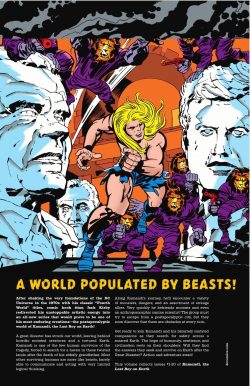

Should you opt for a less strenuous mode of entertainment, the first 20 tales in this Omnibus have been recently released in a trade paperback and digital edition.
Entitled Kamandi by Jack Kirby volume 1 and © 1972, 1973, 1974, 2022 DC Comics. All Rights Reserved., it’s as wonderful an experience without the need for a chiropractor or steroids. As always the internet is your friend here, so go wild guys, gals, gorillas and whatnots…
